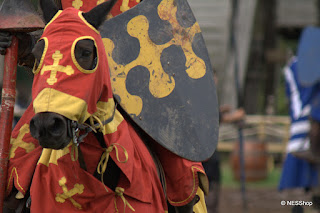Holt Castle
Last night we went to Holt Castle to listen to a talk given by Steve Grenter, Wrexham Heritage Service Manager, on the history and archaeology of Holt Castle. The castle is situated on the banks of the River Dee, on the Welsh side of the border.
The castle was built between 1282 and 1311 by John de Warren, an Earl of Surrey, and the castle appears almost unique in Britain for its unusual pentagonal design.
Online records relating to John de Warren's life and death are conflicting and at this time I am unsure whether he was the 6th, 7th or 8th Earl of Surrey (various online resources differ on this particular point) and as such will refer to my books in due course.
What is clear is that a John de Warren was very significant in the life of Edward I and was awarded lands in North Wales along with other Marcher Lords. Holt Castle was constructed as a headquarters for the Earl in Wales.
The remains of the castle are limited to the remnant central courtyard area which has undergone significant restoration in recent years to remove vegetation and promote its safe retention on site.
The bedrock of red sandstone with masonry above is now clearly visible although the towers have long since gone, demolished following the civil war. Much of the surrounding bedrock has also been quarried to build near by structures and develop the village of Holt itself.
In the mid 14th century the castle was inherited by the FitzAlans however was seized by Richard II from Richard FitzAlan, Earl of Arundel, following an accusation of treason. Richard II amassed gold there just prior to his surrender. When Henry Bolingbrook took the throne to become Henry IV he restored the castle, and lands, to the FitzAlans through Richard FitzAlan's son, Thomas.
Image Credit: Wikipedia A reconstruction of Holt Castle in 1495
Image Credit: Wikipedia A reconstruction of Holt Castle in 1495
The 15th century saw the castle pass to Sir William Stanley who played a significant role in the outcome of the Wars of the Roses, famously changing sides at the Battle of Bosworth and aiding the defeat of Richard III however he was charged with treason only a few years later for allegedly supporting the pretender Perkin Warbeck, who claimed to be the younger of the two princes in the tower, and was executed.
Following Stanley's execution the castle remained in royal hands until the Civil War in the 17th century where it held out to several significant attacks made by parliamentary forces, but was surrendered around 1647 when it became apparent that the kings cause was lost. A local landowner bought the rights to salvage the stone and local residents reclaimed the castle and its grounds, utilising it for recreational activities such as fetes.
Image Credit: Holt Village - showing the south view of Holt Castle, Samuel & Nathaniel Buck 1742 © National Library of Wales, the remnant watergate, a high walled structure leading down to the banks of the River Dee, can be seen in the foreground.








This is fascinating. The reconstruction picture looks quite unusual. I love imagining how things were.
ReplyDeleteThank you :0) you don't need much to fill in the blanks do you, the setting often gives away the justification for the development of a stronghold at that point, but this design is beautiful. I suspect Edward I's castle builder James of St George had something to do with it. Great history here too.
ReplyDelete